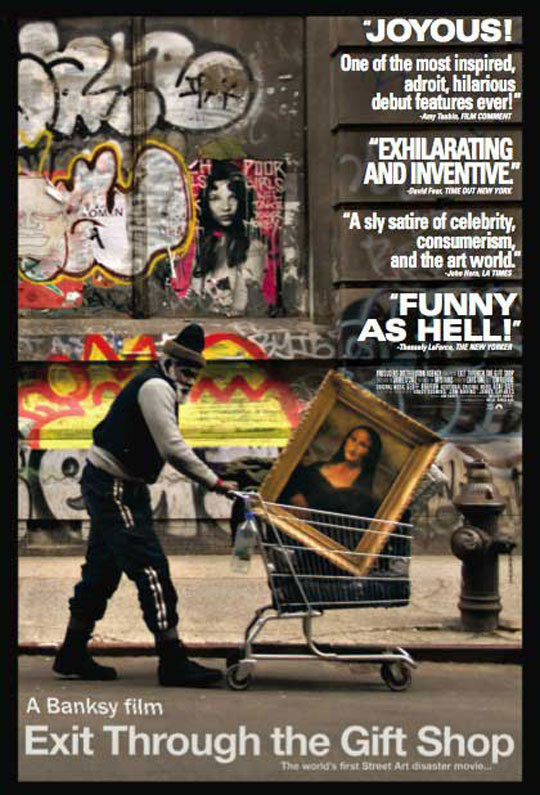
Banksy, the elusive street art icon, is a name synonymous with impactful visuals and thought-provoking social commentary. While initially skeptical of graffiti as an art form, the stencil work and the powerful messages behind Banksy’s pieces became undeniably captivating. However, a turning point arrived when encountering criticism of Banksy’s work on the West Bank wall, raising questions about the intent and impact of even well-meaning street art. This personal journey of grappling with street art’s complexities leads us to Banksy’s most debated creation: Exit Through the Gift Shop, a 2010 film presented as a documentary exploring the world of street art. But is it truly a documentary, or something more subversive?

Mysterious silhouette of Banksy introducing “Exit Through the Gift Shop”, hinting at the film’s enigmatic nature and Banksy’s own concealed identity.
The film opens with Banksy himself, setting the stage by explaining the documentary’s unusual origin. Initially, Thierry Guetta, a French immigrant living in Los Angeles, was attempting to make a film about Banksy. However, Banksy, finding Guetta’s story more compelling, turned the camera around, making Guetta the subject of Exit Through the Gift Shop. Guetta’s entry into the street art scene was accidental, sparked by his cousin, the renowned street artist Space Invader. Fueled by an obsessive habit of filming everything, Guetta amassed a vast archive of footage, unintentionally capturing rare moments of street artists at work, a world typically shrouded in secrecy and fleeting by nature due to its illegal status. This footage became the foundation of Guetta’s initial documentary attempt, driven by his ultimate ambition to meet and film Banksy, a figure as famous as he was inaccessible. Through a stroke of chance, Guetta’s persistence paid off, leading him into Banksy’s inner circle. The first hour of the film is a captivating chronicle of Guetta’s journey into the underground world of street art, showcasing the clandestine creation process and featuring prominent artists in their element.
When Guetta presents his “documentary” to Banksy, the reaction is far from enthusiastic. Banksy, unimpressed with Guetta’s filmmaking, suggests a role reversal: Banksy would try to salvage the documentary, and Guetta should try his hand at creating street art. This pivot marks the film’s second act, where Guetta, now under the moniker “Mr. Brainwash,” embarks on a bizarre artistic journey. Instead of genuine artistic creation, we witness Guetta directing a team to execute derivative works, blatantly borrowing styles and ideas from established artists like Banksy and Shepard Fairey. Notably absent is any evidence of Guetta’s own artistic process; he functions solely as a manager, instructing others. This culminates in Mr. Brainwash’s debut art exhibition, a spectacle that defies artistic merit yet attracts massive crowds and generates astonishing sales, turning Guetta into an overnight art market sensation. The film concludes by briefly updating viewers on the featured artists, with Banksy’s final word being a declaration to never again participate in a film about street art.

Iconic Banksy rat stencil art in “Exit Through the Gift Shop”, symbolizing anonymity, rebellion, and the underlying themes of street art culture explored in the film.
The ambiguous nature of Exit Through the Gift Shop has fueled numerous interpretations and theories. One perspective accepts the film at face value, viewing it as a genuine documentary of Thierry Guetta’s improbable rise in the art world. This reading often leads to disdain for Mr. Brainwash, seen as a charlatan capitalizing on hype and imitation. Conversely, another prominent theory posits that the entire film is a carefully orchestrated mockumentary, a hoax from start to finish. This interpretation suggests that everything was staged, with no pretense of factual accuracy. A more nuanced view positions the film somewhere in the gray area between these extremes. It suggests that the initial hour, documenting Guetta’s immersion in the street art scene, likely contains authentic footage. However, the latter part, focusing on Mr. Brainwash’s art career, veers into satire and possibly staged scenarios. This interpretation aligns with Banksy’s established history of subversive pranks and his critical stance on artistic commercialization. Given Banksy’s roots in anti-establishment street art and his increasing criticism for perceived “selling out,” the Mr. Brainwash narrative can be seen as a satirical commentary on the art market itself. The fact that Mr. Brainwash’s art is conspicuously derivative, coupled with Banksy’s reputation for elaborate hoaxes, strengthens the argument for a satirical intent.

Thierry Guetta as Mr. Brainwash in “Exit Through the Gift Shop”, embodying the persona of an overnight art sensation, raising questions about authenticity and hype in the contemporary art world.
Regardless of the degree of authenticity in its later half, Exit Through the Gift Shop undeniably presents compelling footage of street artists and their craft in its initial segments. In a world saturated with commercialized and often uninspired art, the film celebrates the raw energy and immediacy of street art, an art form that prioritizes impactful messaging over permanence. The film, whether factual or satirical, effectively highlights the power of branding and hype in the art world. The enthusiastic reception and financial success of Mr. Brainwash’s derivative art, ostensibly endorsed by Banksy, underscores a critical message: public perception and the narrative surrounding an artist can often outweigh the intrinsic merit of the artwork itself. Exit Through the Gift Shop (2010) stands as a captivating and thought-provoking film, blurring the lines between documentary and satire, prompting viewers to question the nature of art, authenticity, and the forces that shape the art market. It’s a highly recommended watch for anyone interested in street art, Banksy, and the fascinating intersection of art and commerce.
Wolfman Moon Scale: Full Moon (Highly Recommended)

